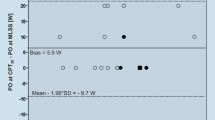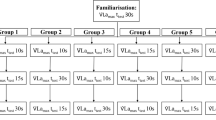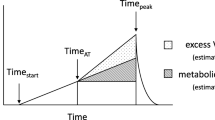Abstract
Purpose
There is no convincing evidence for the idea that a high power output at the maximal lactate steady state (PO_MLSS) and a high fraction of \(\dot{V}\)O2max at MLSS (%\(\dot{V}\)O2_MLSS) are decisive for endurance performance. We tested the hypotheses that (1) %\(\dot{V}\)O2_MLSS is positively correlated with the ability to sustain a high fraction of \(\dot{V}\)O2max for a given competition duration (%\(\dot{V}\)O2_TT); (2) %\(\dot{V}\)O2_MLSS improves the prediction of the average power output of a time trial (PO_TT) in addition to \(\dot{V}\)O2max and gross efficiency (GE); (3) PO_MLSS improves the prediction of PO_TT in addition to \(\dot{V}\)O2max and GE.
Methods
Twenty-one recreationally active participants performed stepwise incremental tests on the first and final testing day to measure GE and check for potential test-related training effects in terms of changes in the minimal lactate equivalent power output (∆PO_LEmin), 30-min constant load tests to determine MLSS, a ramp test and verification bout for \(\dot{V}\)O2max, and 20-min time trials for %\(\dot{V}\)O2_TT and PO_TT. Hypothesis 1 was tested via bivariate and partial correlations between %\(\dot{V}\)O2_MLSS and %\(\dot{V}\)O2_TT. Multiple regression models with \(\dot{V}\)O2max, GE, ∆PO_LEmin, and %\(\dot{V}\)O2_MLSS (Hypothesis 2) or PO_MLSS instead of %\(\dot{V}\)O2_MLSS (Hypothesis 3), respectively, as predictors, and PO_TT as the dependent variable were used to test the hypotheses.
Results
%\(\dot{V}\)O2_MLSS was not correlated with %\(\dot{V}\)O2_TT (r = 0.17, p = 0.583). Neither %\(\dot{V}\)O2_MLSS (p = 0.424) nor PO_MLSS (p = 0.208) did improve the prediction of PO_TT in addition to \(\dot{V}\)O2max and GE.
Conclusion
These results challenge the assumption that PO_MLSS or %\(\dot{V}\)O2_MLSS are independent predictors of supra-MLSS PO_TT and %\(\dot{\text{V}}\)O2_TT.


Similar content being viewed by others
Availability of data and materials
Data are available upon reasonable request.
Abbreviations
- BLC:
-
Blood lactate concentration
- BLCmax :
-
Maximum blood lactate concentration
- BLC_TT :
-
Average blood lactate concentration during the time trial
- GE:
-
Gross efficiency
- H+ :
-
Hydrogen ions
- LEmin :
-
Minimal lactate equivalent
- MLSS:
-
Maximal lactate steady state
- PO:
-
Power output
- PO_LEmin :
-
Power output at minimal lactate equivalent
- PO_MLSS :
-
Power output at maximal lactate steady state
- PO_TT :
-
Average power output of the time trial
- PO_V̇O2max :
-
Power output at maximal oxygen uptake per minute
- PPO:
-
Peak power output
- ΔPO_LEmin:
-
Difference in power output at minimal lactate equivalent between the first and the final testing day
- RERmax :
-
Maximal respiratory exchange ratio
- \(\dot{\text{V}}\text{O}_{2}\) :
-
Oxygen uptake per minute
- \(\dot{\text{V}}\text{O}_{2}\) :
-
Maximal oxygen uptake per minute
- %\(\dot{\text{V}}\)̇O2_LT :
-
Percentage utilization of V̇O2max at lactate threshold
- %\(\dot{\text{V}}\)̇O2_MLSS :
-
Percentage utilization of \(\dot{\text{V}}\)̇O2max at maximal lactate steady state
- %\(\dot{\text{V}}\)O2_TT :
-
Average percentage utilization of \(\dot{\text{V}}\)O2max during the superior time trial
References
Allen WK, Seals DR, Hurley BF et al (1985) Lactate threshold and distance-running performance in young and older endurance athletes. J Appl Physiol 58:1281–1284. https://doi.org/10.1152/jappl.1985.58.4.1281
Allen DG, Lamb GD, Westerblad H (2008) Skeletal muscle fatigue: cellular mechanisms. Physiol Rev 88:287–332. https://doi.org/10.1152/physrev.00015.2007
Aunola S, Rusko H (1984) Reproducibility of aerobic and anaerobic thresholds in 20–50 year old men. Eur J Appl Physiol Occup Physiol 53:260–266. https://doi.org/10.1007/BF00776600
Bassett DR, Howley ET (2000) Limiting factors for maximum oxygen uptake and determinants of endurance performance. Med Sci Sports Exerc 32:70–84. https://doi.org/10.1097/00005768-200001000-00012
Beneke R (1995) Anaerobic threshold, individual anaerobic threshold, and maximal lactate steady state in rowing. Med Sci Sports Exerc 27:863–867
Beneke R (2003) Methodological aspects of maximal lactate steady state—implications for performance testing. Eur J Appl Physiol 89:95–99. https://doi.org/10.1007/s00421-002-0783-1
Beneke R, Leithäuser RM (2017) Maximal lactate steady state’s dependence on cycling cadence. Int J Sports Physiol Perform 12:304–309. https://doi.org/10.1123/ijspp.2015-0573
Beneke R, Hütler M, Leithäuser RM (2000) Maximal lactate-steady-state independent of performance. Med Sci Sports Exerc 32:1135–1139. https://doi.org/10.1097/00005768-200006000-00016
Beneke R, Pollmann C, Bleif I et al (2002) How anaerobic is the wingate anaerobic test for humans? Eur J Appl Physiol 87:388–392. https://doi.org/10.1007/s00421-002-0622-4
Beneke R, Leithäuser RM, Ochentel O (2011) Blood lactate diagnostics in exercise testing and training. Int J Sports Physiol Perform 6:8–24. https://doi.org/10.1123/ijspp.6.1.8
Billat LV (1996) Use of blood lactate measurements for prediction of exercise performance and for control of training. Recommendations for long-distance running. Sports Med 22:157–175. https://doi.org/10.2165/00007256-199622030-00003
Billat VL, Sirvent P, Py G et al (2003) The concept of maximal lactate steady state: a bridge between biochemistry, physiology and sport science. Sports Med 33:407–426. https://doi.org/10.2165/00007256-200333060-00003
Bosquet L, Leger L, Legros P (2002) Methods to determine aerobic endurance. Sports Med 32:675–700. https://doi.org/10.2165/00007256-200232110-00002
Cairns SP (2006) Lactic acid and exercise performance: culprit or friend? Sports Med 36:279–291. https://doi.org/10.2165/00007256-200636040-00001
Costill DL, Thomason H, Roberts E (1973) Fractional utilization of the aerobic capacity during distance running. Med Sci Sports 5:248–252
Coyle EF (1995) Integration of the physiological factors determining endurance performance ability. Exerc Sport Sci Rev 23:25–63
Coyle EF, Coggan AR, Hopper MK, Walters TJ (1988) Determinants of endurance in well-trained cyclists. J Appl Physiol 64:2622–2630. https://doi.org/10.1152/jappl.1988.64.6.2622
Coyle EF, Feltner ME, Kautz SA et al (1991) Physiological and biomechanical factors associated with elite endurance cycling performance. Med Sci Sports Exerc 23:93–107
Denadai BS, de Ruas VD, Figueira TR (2006) Maximal lactate steady state concentration independent of pedal cadence in active individuals. Eur J Appl Physiol 96:477–480. https://doi.org/10.1007/s00421-005-0090-8
Denis C, Fouquet R, Poty P et al (1982) Effect of 40 weeks of endurance training on the anaerobic threshold. Int J Sports Med 3:208–214. https://doi.org/10.1055/s-2008-1026089
Edwards AM, Clark N, Macfadyen AM (2003) Lactate and ventilatory thresholds reflect the training status of professional soccer players where maximum aerobic power is unchanged. J Sports Sci Med 2:23–29
Ettema G, Lorås HW (2009) Efficiency in cycling: a review. Eur J Appl Physiol 106:1–14. https://doi.org/10.1007/s00421-009-1008-7
Garcia-Tabar I, Gorostiaga EM (2018) A “blood relationship” between the overlooked minimum lactate equivalent and maximal lactate steady state in trained runners. Back to the old days? Front Physiol. 9:1034. https://doi.org/10.3389/fphys.2018.01034
Graham PL, Zoeller RF, Jacobs PL, Whitehurst MA (2018) Effect of cadence on time trial performance in recreational female cyclists. J Strength Cond Res 32:1739–1744. https://doi.org/10.1519/JSC.0000000000002044
Greco CC, Caritá RAC, Dekerle J, Denadai BS (2012) Effect of aerobic training status on both maximal lactate steady state and critical power. Appl Physiol Nutr Metab 37:736–743. https://doi.org/10.1139/h2012-047
Harnish CR, Swensen TC, Pate RR (2001) Methods for estimating the maximal lactate steady state in trained cyclists. Med Sci Sports Exerc 33:1052–1055. https://doi.org/10.1097/00005768-200106000-00027
Hauser T, Adam J, Schulz H (2013) Comparison of selected lactate threshold parameters with maximal lactate steady state in cycling. Int J Sports Med 35:517–521. https://doi.org/10.1055/s-0033-1353176
Haverty M, Kenney WL, Hodgson JL (1988) Lactate and gas exchange responses to incremental and steady state running. Br J Sports Med 22:51–54. https://doi.org/10.1136/bjsm.22.2.51
Heck H, Mader A, Hess G et al (1985) Justification of the 4-mmol/l lactate threshold. Int J Sports Med 06:117–130. https://doi.org/10.1055/s-2008-1025824
Heinze G, Wallisch C, Dunkler D (2018) Variable selection—a review and recommendations for the practicing statistician. Biom J 60:431–449. https://doi.org/10.1002/bimj.201700067
Iannetta D, de Almeida AR, Ingram CP et al (2020) Evaluating the suitability of supra-POpeak verification trials after ramp-incremental exercise to confirm the attainment of maximum O2 uptake. Am J Physiol Regul Integr Comp Physiol 319:R315–R322. https://doi.org/10.1152/ajpregu.00126.2020
Jamnick NA, Botella J, Pyne DB, Bishop DJ (2018) Manipulating graded exercise test variables affects the validity of the lactate threshold and V˙O2peak. PLoS ONE 13:e0199794. https://doi.org/10.1371/journal.pone.0199794
Jones AM, Carter H (2000) The effect of endurance training on parameters of aerobic fitness. Sports Med 29:373–386. https://doi.org/10.2165/00007256-200029060-00001
Jones AM, Doust JH (1998) The validity of the lactate minimum test for determination of the maximal lactate steady state. Med Sci Sports Exerc 30:1304–1313. https://doi.org/10.1097/00005768-199808000-00020
Jones AM, Burnley M, Black MI et al (2019) Response to considerations regarding maximal lactate steady state determination before redefining the gold-standard. Physiol Rep. https://doi.org/10.14814/phy2.14292
Jones AM, Burnley M, Black MI et al (2019) The maximal metabolic steady state redefining the ‘gold standard.’ Physiol Rep 7:e14098. https://doi.org/10.14814/phy2.14098
Joyner MJ, Coyle EF (2008) Endurance exercise performance: the physiology of champions: factors that make champions. J Physiol 586:35–44. https://doi.org/10.1113/jphysiol.2007.143834
Kent-Braun JA, Fitts RH, Christie A (2012) Skeletal muscle fatigue. Compr Physiol 2:997–1044. https://doi.org/10.1002/cphy.c110029
Klitzke Borszcz F, Ferreira Tramontin A, Pereira Costa V (2019) Is the functional threshold power interchangeable with the maximal lactate steady state in trained cyclists? Int J Sports Physiol Perform 14:1029–1035. https://doi.org/10.1123/ijspp.2018-0572
Knaier R, Infanger D, Niemeyer M et al (2019) In athletes, the diurnal variations in maximum oxygen uptake are more than twice as large as the day-to-day variations. Front Physiol 10:219. https://doi.org/10.3389/fphys.2019.00219
Knuth ST, Dave H, Peters JR, Fitts RH (2006) Low cell pH depresses peak power in rat skeletal muscle fibres at both 30 °C and 15 °C: implications for muscle fatigue: low cell pH depresses power. J Physiol 575:887–899. https://doi.org/10.1113/jphysiol.2006.106732
Lillo-Beviá JR, Courel-Ibáñez J, Cerezuela-Espejo V et al (2019) Is the functional threshold power a valid metric to estimate the maximal lactate steady state in cyclists? J Strength Cond Res. https://doi.org/10.1519/JSC.0000000000003403
Mantel N (1970) Why stepdown procedures in variable selection. Technometrics 12:621–625. https://doi.org/10.1080/00401706.1970.10488701
McLaughlin JE, Howley ET, Bassett DR et al (2010) Test of the classic model for predicting endurance running performance. Med Sci Sports Exerc 42:991–997. https://doi.org/10.1249/MSS.0b013e3181c0669d
Morgan DW, Baldini FD, Martin PE, Kohrt WM (1989) Ten kilometer performance and predicted velocity at VO2max among well-trained male runners. Med Sci Sports Exerc 21:78–83. https://doi.org/10.1249/00005768-198902000-00014
Murgatroyd SR, Ferguson C, Ward SA et al (2011) Pulmonary O2 uptake kinetics as a determinant of high-intensity exercise tolerance in humans. J Appl Physiol (1985) 110:1598–1606. https://doi.org/10.1152/japplphysiol.01092.2010
Nelson CR, Fitts RH (2014) Effects of low cell pH and elevated inorganic phosphate on the pCa-force relationship in single muscle fibers at near-physiological temperatures. Am J Physiol Cell Physiol 306:C670–C678. https://doi.org/10.1152/ajpcell.00347.2013
Niemeyer M, Leithaeuser R, Beneke R (2019a) Oxygen uptake plateau occurrence depends on oxygen kinetics and oxygen deficit accumulation. Scand J Med Sci Sports 29:1466–1472. https://doi.org/10.1111/sms.13493
Niemeyer M, Weber TGJ, Beneke R (2019b) Higher energy and carbohydrate demand of interval training at a given average velocity on track versus treadmill. Appl Physiol Nutr Metab 44:447–449. https://doi.org/10.1139/apnm-2018-0596
Niemeyer M, Bergmann TGJ, Beneke R (2020) Oxygen uptake plateau: calculation artifact or physiological reality? Eur J Appl Physiol 120:231–242. https://doi.org/10.1007/s00421-019-04267-7
Péronnet F, Massicotte D (1991) Table of nonprotein respiratory quotient: an update. Can J Sport Sci 16:23–29
Rabinowitz JD, Enerbäck S (2020) Lactate: the ugly duckling of energy metabolism. Nat Metab 2:566–571. https://doi.org/10.1038/s42255-020-0243-4
Robergs RA, Dwyer D, Astorino T (2010) Recommendations for improved data processing from expired gas analysis indirect calorimetry. Sports Med 40:95–111. https://doi.org/10.2165/11319670-000000000-00000
Sundberg CW, Fitts RH (2019) Bioenergetic basis of skeletal muscle fatigue. Curr Opin Physiol 10:118–127. https://doi.org/10.1016/j.cophys.2019.05.004
Triska C, Karsten B, Heidegger B et al (2017) Reliability of the parameters of the power-duration relationship using maximal effort time-trials under laboratory conditions. PLoS ONE 12:e0189776. https://doi.org/10.1371/journal.pone.0189776
Wagner J, Niemeyer M, Infanger D et al (2020) New data-based cutoffs for maximal exercise criteria across the lifespan. Med Sci Sports Exerc 52:1915–1923. https://doi.org/10.1249/MSS.0000000000002344
Watson G, Swensen T (2006) Effects of altering pedal cadence on cycling time-trial performance. Int J Sports Med 27:296–300. https://doi.org/10.1055/s-2005-865654
Weltman A, Snead D, Stein P et al (1990) Reliability and validity of a continuous incremental treadmill protocol for the determination of lactate threshold, fixed blood lactate concentrations, and VO2max. Int J Sports Med 11:26–32. https://doi.org/10.1055/s-2007-1024757
Westerblad H (2016) Acidosis is not a significant cause of skeletal muscle fatigue. Med Sci Sports Exerc 48:2339–2342. https://doi.org/10.1249/MSS.0000000000001044
Acknowledgements
We thank all persons who made this study possible by their participation
Funding
Raphael Knaier was funded by the Swiss National Science Foundation (Grant P2BSP3_191755).
Author information
Authors and Affiliations
Contributions
MN: conceived and designed research, conducted experiments, analyzed data and wrote the manuscript. MG and GS collected data. RK and RB interpreted data, wrote and critically revised the manuscript. All authors intellectually contributed to revising the article and approved the final version.
Corresponding author
Ethics declarations
Conflict of interest
The authors declare that they have no conflict of interest.
Ethical approval
All procedures performed in studies involving human participants were in accordance with the ethical standards of the institutional and/or national research committee (Ethics committee of Philipps-University Marburg, FB21-AZ4-07-19) and with the 1964 Helsinki declaration and its later amendments or comparable ethical standards.
Consent to participate
All participants gave their written informed consent after an explanation of the experimental procedure and associated risks.
Additional information
Communicated by Jean - Rene Lacour.
Publisher's Note
Springer Nature remains neutral with regard to jurisdictional claims in published maps and institutional affiliations.
Rights and permissions
About this article
Cite this article
Niemeyer, M., Gündisch, M., Steinecke, G. et al. Is the maximal lactate steady state concept really relevant to predict endurance performance?. Eur J Appl Physiol 122, 2259–2269 (2022). https://doi.org/10.1007/s00421-022-05001-6
Received:
Accepted:
Published:
Issue Date:
DOI: https://doi.org/10.1007/s00421-022-05001-6




